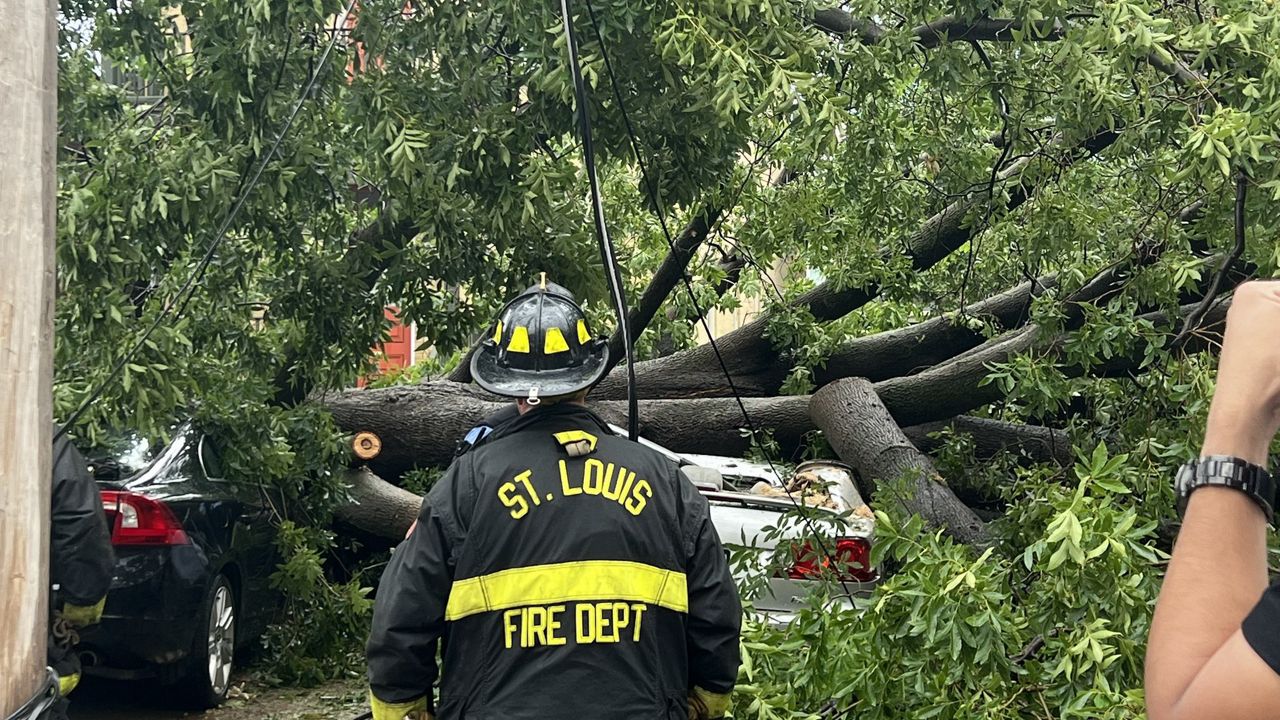ST. LOUIS—Public safety officials in the city said Wednesday they want to hear from anyone who tried calling the 911 system during the height of Saturday’s severe weather which left a St. Louis woman dead when a tree fell on her car. After concerns were raised over delays in reaching dispatchers, authorities held a news conference to explain the mechanics of how emergency calls are handled and staffing levels, and new challenges brought on by a line item veto in the state budget.
Katherine Coen, 33, was in a vehicle on the 4100 block of Chouteau Saturday when severe weather swept through the St. Louis region between 3 p.m. and 5 p.m. Helen Petty, a hair salon owner, said Coen was a customer who was waiting out the storm in a car when the tree fell. Petty, a 2023 candidate for the St. Louis Board of Aldermen, said someone tried calling 911 for more than 30 minutes. Someone else later got through. Petty said Coen was responsive at first and had a pulse when crews arrived, but was pronounced dead on the scene.
At a news conference Wednesday morning authorities said the call about the Chouteau scene came in at 4:16 p.m. Saturday and the first responding fire crew arrived at 4:24 p.m. The call came into the St. Louis EMS.
Late Wednesday afternoon, the Department of Public Safety said EMS first answered a call at 3:57 p.m. while police first took a call on it at 4:14 p.m. A spokesperson said the first fire unit on scene arrived at 4:29 p.m.
"Units based at firehouses in proximity to this incident were already responding to storm-related emergencies in other areas of the city, with Fire performing 45 runs during this time period. This case remains under review by the Department of Public Safety," spokesman Monte Chambers said in a news release.
While it is now unclear what time fire units were first dispatched to the scene, Nick Desideri, a spokesman for Mayor Tishaura Jones said Wednesday night that knowing a 911 caller was able to speak to someone at 3:57 p.m. Saturday is a step toward dispelling fears that people were unable reach authorities for help.
That's why the city is asking for the public's help.
“The things we need to know from the public are if they contacted 911, what number they contacted from because we can track that, but what is also important for everyone to know, is if there was some sort of busy signal or telecommunications challenge we would need to know that too,” said St. Louis Metropolitan Police Major Eric Larson.
Calls not picked up within a minute and a half automatically go to a rollover system where callers can then access EMS, fire or police dispatch.
It was unclear if any calls went unanswered Saturday. The system is designed to automatically call back a number if someone hangs up during an active call.
“Calls are answered in the order received so if they call and they hang up, and then they call back, they’re going to the back of the line and that’s causing a lot of challenges and frustration on the public’s end, because they’re trying to get through and they’re trying to get through but the way this system is designed by hanging up, you go back to the end of the line,” Larson said.
Saturday staffing
Officials said there were four people taking calls during this shift on Saturday, with three fire dispatchers, four EMS dispatchers and five police 911 dispatchers. In total they handled 1,076 calls between 3-5 p.m., an average of nine calls a minute according to the Department of Public Safety. Of those 1,076 calls, 605 were for emergencies.
The city has 40 vacancies for 911 dispatchers and ideally would have had 10 working during the storm instead of five, according to Charles Coyle, the St. Louis City Public Safety Director. He also said the city is short 10 EMS dispatchers. Officials did set a new job classification to have dispatchers who are cross-trained for all three contingencies but doesn’t have enough manpower to take employees out of circulation to do the cross-training.
Pay raises for dispatchers under the 2024 budget that is now in effect will help the city be more competitive in the region, and a bill sitting on Governor Mike Parson’s desk would also clear the residency requirement for all city employees, which would help expand the potential labor pool.
A new 911 center
St. Louis has been working on plans for a new $42 million Public Safety Access Point, or PSAP, which would house all 911 operations in one place in an effort to improve public safety, cut down on wait times and provide a more modern response. The facility is to be built on the campus of the St. Louis Fire Department’s headquarters at Jefferson and Cass. St. Louis plans to use $15 million in federal American Rescue Plan funds, along with $5 million in city funds. On Friday, Gov. Parson cut the city’s request for $20 million toward the project in half.
“It may have an impact but we have work to do. We’re gonna have to find $10 million because the PSAP is critical,” Public Safety Director Charles E. Coyle said Wednesday. “It’s critical to the safety of our city, its critical for the first responders as well, so we’re going to be working here to see if we can find the funding to complete construction of PSAP.”
Under the current timeline, the new facility would be operational by either late 2025 or the first quarter of 2026.



